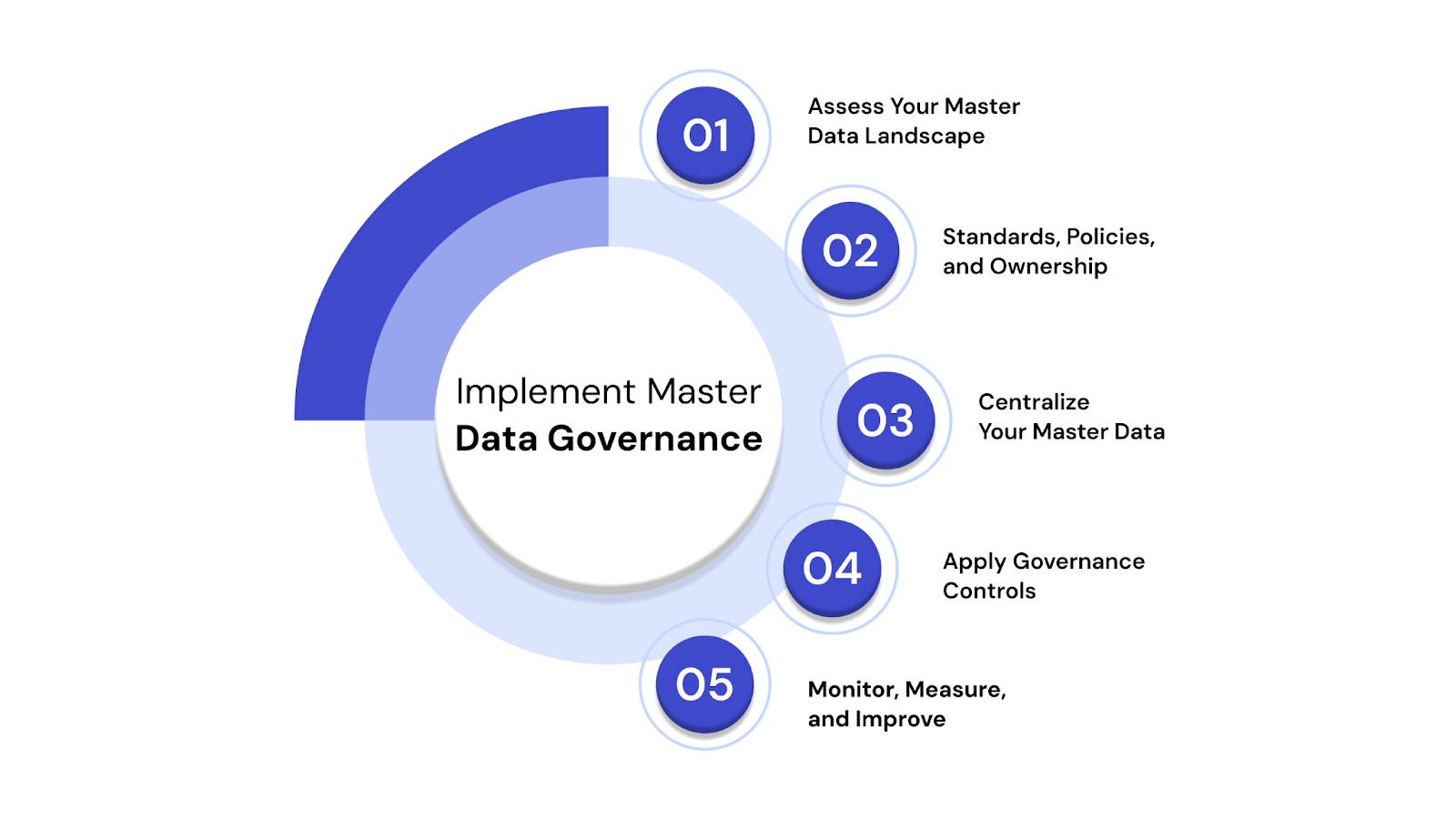

Master data is the connective tissue of any organization — customer records, product catalogs, vendor lists, and location hierarchies. When this core data is inconsistent or poorly managed, it doesn’t just slow things down — it affects decisions, compliance, revenue, and trust across the business.
That’s why Master Data Governance (MDG) matters more than ever. It’s not just a set of policies or tools — it’s a structured approach to defining ownership, setting standards, and enforcing quality across systems and teams.
This guide walks through what MDG looks like in practice: how to build a scalable governance framework, where teams usually get stuck, and what trends are reshaping how organizations manage master data in 2025 and beyond.
Whether you're launching a new governance initiative or trying to fix what’s already in place, this is a practical resource to help you do it right.
TL;DR — Key Takeaways
Master Data Governance (MDG) is the framework of processes, roles, policies, standards, and tools that ensure the quality, consistency, and accountability of your most critical business data — your master data.
In practical terms, MDG answers questions like:
Master data itself refers to core business entities that are used repeatedly across business processes and systems. These include:
You can think of MDG as the discipline that brings MDM to life, ensuring that rules are enforced, ownership is assigned, and quality is maintained.
Many teams confuse MDM platforms with governance itself. But governance is about responsibility, process, and discipline — not just tooling. It’s possible to have a powerful MDM platform and still face poor data quality if governance is missing.
That’s why a strong MDG approach must include:
Master data is at the core of almost every business process — from customer onboarding and invoicing to reporting, forecasting, and supply chain operations. When this foundational data is inconsistent, incomplete, or duplicated across systems, the consequences ripple through the entire organization.
That’s where master data governance (MDG) becomes essential. It’s not just about data quality — it’s about operational efficiency, compliance, and the ability to make confident, informed decisions.
Without MDG, different systems often maintain different versions of the same entity, leading to errors like:
By governing master data centrally, businesses create a single source of truth that supports consistent operations across departments and platforms.
Time and resources are often wasted resolving issues caused by poor data:
With governed master data, workflows are faster, cleaner, and more scalable — especially when integrated across ERP, CRM, and analytics platforms.
Data privacy laws like GDPR, CCPA, and HIPAA increasingly require businesses to demonstrate data accuracy, lineage, and controlled access. MDG helps enforce:
This makes audits easier and reduces the risk of non-compliance penalties.
Even advanced BI tools are only as reliable as the data feeding them. Poorly governed master data undermines metrics, KPIs, and forecasting models. MDG ensures:
Want to learn more about improving data quality across analytics systems? Read Mastering Data Engineering: A Complete Guide.
Data-driven technologies like AI, machine learning, and automation require structured, consistent, high-quality data. Without the MDG in place:
MDG helps ensure your business is ready to scale with AI, not hindered by it.

Master data governance isn’t a single tool or policy — it’s a coordinated system of people, processes, and technology that work together to manage and maintain high-quality master data.
Here are the foundational components every effective MDG strategy needs:
Clear ownership is one of the most overlooked — and most critical — parts of any governance framework. Every data domain (e.g., customer, product, vendor) should have:
Establishing these roles ensures there’s always someone accountable for maintaining high-quality master data.
Without shared standards, teams interpret data differently. MDG enforces:
These rules are the foundation for consistency and downstream data trust.
A data catalog helps you:
Governance without visibility is guesswork — cataloging brings structure and accountability to your data ecosystem.
Want to explore this further? Read Understanding What is Data Preparation to learn how metadata and profiling help improve quality at the source.
Master data must evolve, but it needs to do so in a controlled, auditable way. That means:
These controls reduce human error and help meet compliance standards.
From creation to archival, master data should follow a managed lifecycle:
This prevents outdated or irrelevant data from polluting systems.

Implementing a master data governance (MDG) framework doesn’t have to be overwhelming. Whether you're starting from scratch or strengthening existing efforts, the key is to follow a structured, phased approach that aligns with your business goals and data realities.
Here’s a practical roadmap to help you move from scattered data to governed, trusted master records:
Begin by identifying where your master data lives — and what condition it’s in.
This discovery phase gives you a baseline for setting governance goals.
🔗 Related: Guide to Testing Data Pipelines
Next, lay the foundation of your governance model:
These decisions will guide automation later — so collaboration across IT, legal, and business teams is essential.
Bring data together into a trusted system of record:
If you're modernizing your infrastructure, this step can align well with broader data platform or pipeline initiatives.
Put governance into action through automated workflows and approvals:
This step is where your policies become enforceable — not just theoretical.
Governance isn’t “one and done.” Continually track data quality, adoption, and policy compliance.
At QuartileX, we help organizations design and implement governance workflows that scale — whether you're just getting started or looking to level up an existing framework.
While the benefits of master data governance are clear, the path to implementation isn’t without its hurdles. From organizational silos to legacy systems and shifting regulations, businesses often encounter roadblocks that can stall or derail governance initiatives.
Here’s a look at the most common challenges — and strategies to overcome them:
The problem:
Departments often maintain their own datasets with inconsistent formats, definitions, or standards — leading to fragmented views of key entities like customers or products.
The solution:
Explore our blog on Steps to Build a Data Pipeline from Scratch for insights into unifying data across systems.
The problem:
Older systems often lack support for modern data standards, APIs, or integration capabilities, making it hard to align with governance requirements.
The solution:
The problem:
Without clearly defined roles, governance efforts stall. No one knows who’s responsible for fixing bad data or enforcing rules.
The solution:
The problem:
Governance can be deprioritized when teams are stretched or leadership doesn’t fully understand the ROI.
The solution:
The problem:
New privacy laws (like GDPR, CCPA, HIPAA) require governed, auditable data — but keeping up with them is difficult.
The solution:

When implemented effectively, master data governance doesn’t just clean up data — it drives meaningful impact across your entire organization. From smoother operations to smarter decisions, the advantages are both strategic and measurable.
Let’s break down the key benefits:
Poor-quality master data leads to errors in transactions, reporting, and customer interactions. Governance frameworks enforce data standards and validation rules, resulting in:
When teams trust the data, they stop second-guessing — and start acting.
With privacy regulations tightening globally, companies must demonstrate control over how data is collected, processed, and stored. MDG helps by:
This reduces compliance risk and simplifies audits.
Data issues are costly — both in time and resources. With a strong MDG foundation, companies experience:
Even small improvements in data handling can yield major productivity gains.
Governed master data ensures your dashboards and reports reflect accurate, unified information. This translates to:
Related read: Data Science vs Data Engineering: Key Differences & Why Both Matter
When departments operate from the same clean, shared data, collaboration becomes easier:
This reduces friction and improves alignment across business functions.
Data platforms, analytics tools, and AI models are only as good as the data they receive. MDG ensures your tech stack delivers value by:
As businesses become more data-driven and regulatory landscapes evolve, master data governance (MDG) must keep up. What worked five years ago — manual reviews, static policies, siloed processes — can’t scale in today’s dynamic environment.
Here are the most important trends shaping the future of MDG in 2025 and beyond:
Manual governance is too slow for modern data ecosystems. Increasingly, organizations are adopting:
This reduces human error, accelerates issue resolution, and allows teams to focus on exceptions rather than routine checks.
Rather than trying to move all data into a single platform, businesses are building data fabrics — interconnected architectures that unify access, governance, and metadata across distributed environments (cloud, on-prem, hybrid).
In this model, governance policies follow the data, wherever it resides.
Regulations like GDPR, CCPA, and India's DPDP are making personal data governance a board-level priority. Organizations are:
Expect consent enforcement to become a core pillar of future MDG frameworks.
AI and machine learning are transforming MDG from reactive to proactive. Key developments include:
These capabilities reduce the burden on human stewards and increase governance precision.
Modern governance tools are shifting toward modular, API-first architectures that integrate easily into cloud ecosystems. This enables:
At QuartileX, we help organizations design cloud-native governance solutions that scale with data complexity — not against it.
Want to better understand how to modernize your data landscape? Read our guide on Cloud Governance Frameworks and Models.
Master data governance has become a business-critical discipline — not just an IT initiative. As organizations deal with more data, more systems, and more compliance risks, a structured governance strategy is no longer optional.
It ensures that your core business data is:
With the right framework, technology, and partners, master data governance can evolve from a challenge into a competitive advantage.
How QuartileX Can Help
At QuartileX, we help organizations move from fragmented, error-prone master data to streamlined governance frameworks that scale with the business.
Whether you're starting from scratch or optimizing existing efforts, our team can help you:
We’ve worked with companies across industries to transform their master data into a strategic asset — and we can help you do the same.
Ready to take control of your master data and future-proof your data operations?
Talk to our experts — and let’s build a smarter, more trusted data foundation together.
Master data is relatively stable and reused across systems (e.g., customer names, product SKUs), while transactional data changes frequently and records specific events (e.g., purchases, payments).
Without MDG, businesses risk duplicate records, compliance violations, poor decision-making, and operational inefficiencies. MDG helps ensure high data quality and supports analytics, automation, and regulatory readiness.
Common tools include data catalogs, ETL/ELT platforms (like Hevo and Fivetran), MDM platforms, data quality engines, and workflow automation systems. At QuartileX, we integrate best-in-class tools tailored to your governance maturity.
Start with a discovery phase: catalog your master data sources, identify inconsistencies, assign ownership, and define policies. Begin with one high-impact domain (like customer or product data) and scale from there.
All data-driven organizations benefit from MDG, but it's especially critical in industries like finance, healthcare, retail, manufacturing, and logistics — where compliance and operational precision are high priorities.
Absolutely. At QuartileX, we provide tailored strategies, tool implementation, and change management support to help organizations build scalable and future-ready master data governance frameworks.
From cloud to AI — we’ll help build the right roadmap.
Kickstart your journey with intelligent data, AI-driven strategies!